The Samsung Galaxy Tab S2 Review
by Brandon Chester on October 15, 2015 8:00 AM ESTBattery Life
Modern tablets typically haven't struggled to last users through the day. Even the original iPad was rated for ten hours of usage, and most tablets from various vendors tend to hit or exceed this target in workloads like web browsing and watching video. However, as manufacturers have tried to slim down their tablets and reduce their mass, they have had to decrease the sizes of the batteries they include. While this can be offset by reductions in overall platform power, if it isn't offset the tablet can struggle to last throughout the day even when performing relatively lightweight tasks.
When the Tab S2 was originally announced I saw concerns regarding the battery capacity of both models. The original Tab S tablets were already very thin, and with both Tab S2 tablets again being the thinnest in their class Samsung has had to reduce the battery capacity of each model. What's also concerning is that the original Tab S tablets had some battery life issues of their own. However, there's really no way to gauge battery life just by looking at a device's battery capacity, and so we turn to our standard suite of battery tests which includes a WiFi web browsing rundown, a video playback test, BaseMark OS II's battery test, PCMark's battery test, and GFXBench 3's battery test.
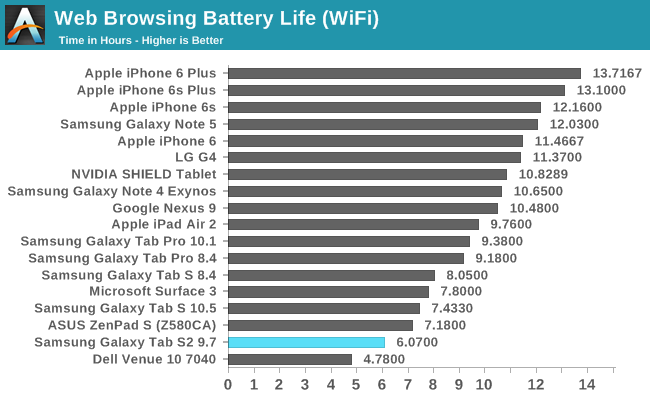
Our web browsing battery life test is mostly display bound, and the Tab S2 does not fare well during it. At 6.07 hours, it's our second lowest result, beating only the Dell Venue 10 7040 which I noted for having exceptionally poor web browsing battery life. It's almost a given that this result is due to the power required by the display, as the high level of white on a common web page will increase AMOLED power consumption dramatically. The results of this test make me question some of the design decisions made during the creation of the Tab S2. Clearly this sort of problem would have shown up during testing, and the Tab S2's platform power is obviously higher than the internal battery can support for an acceptable length of time.

Like its predecessors, the Tab S2 does very well in our video playback battery test. Since the power usage of decoding video is essentially a fixed amount this result is also dependant on display power. In the case of AMOLED devices, the ability to turn off black pixels is a huge advantage and results in the category leading scores that you see above. The smaller battery of the Tab S2 is likely what leads to it trailing the original Tab S tablets by a couple of hours, and while the Tab S2 definitely won't be as good as its predecessors for watching films due to its aspect ratio, it still lasts more than long enough for anyone to sit on a plane or train and watch several films or a season of a TV show.
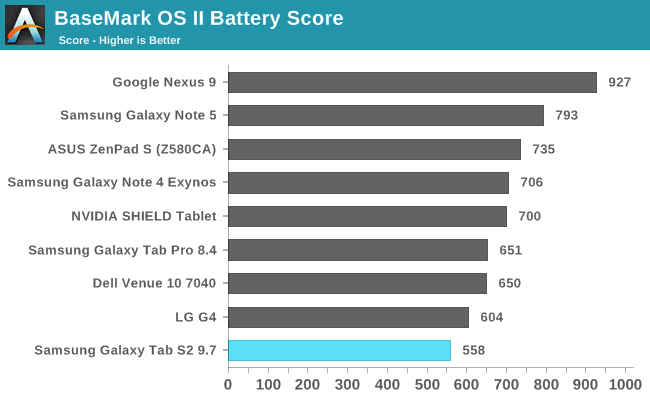
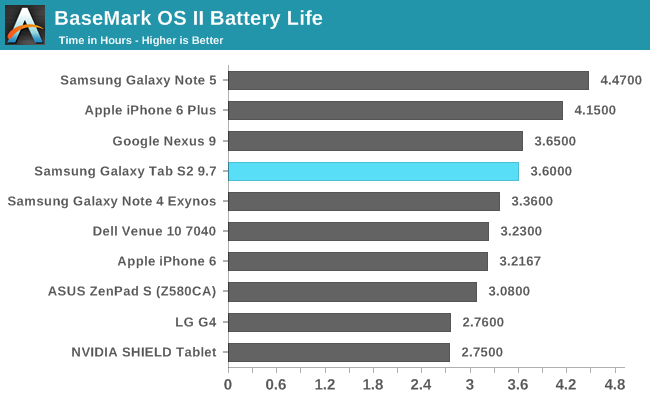
At first glance, the Tab S2 appears to do well in BaseMark OS II's battery test. Its run time is above the median, which should be a good thing. Unfortunately, this test really has two parts to it. Because the BaseMark battery test runs a CPU load over time one has to consider how performant a device was during the duration of the test. In the case of the Tab S2, I saw some of the lowest levels of CPU usage that I've ever seen on a mobile device. The impact of this can be seen in BaseMark's battery score for the Tab S2, which is the lowest device on record. In that sense, the result of BaseMark OS II is actually not favorable for the Tab S2, as it only achieved its run time due to low CPU usage during the test period.
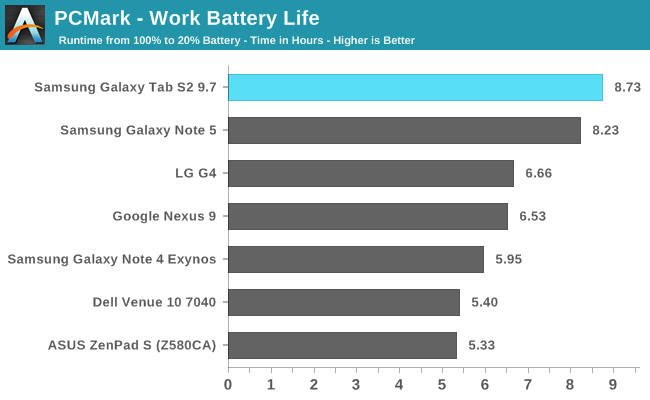
Based on the results so far I wasn't hopeful for a great battery runtime in PCMark's battery test. I was actually quite surprised when the test finished and I saw the Tab S2 with a score far greater than any other tablet. I believe this is because of the relatively long CPU idle periods and lower average display APL than our web browsing test or BaseMark OS II's battery test. What this says is that the Tab S2 is capable of good battery life in a very mixed and balanced workload, but if you're performing any display or CPU heavy tasks for any significant period of time you're going to experience the high levels of battery drain demonstrated in the earlier tests.
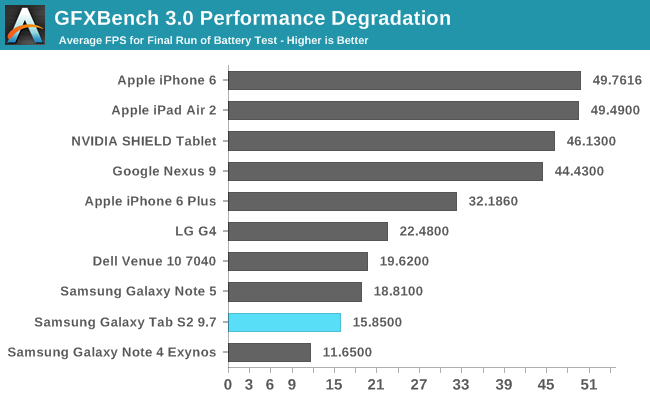
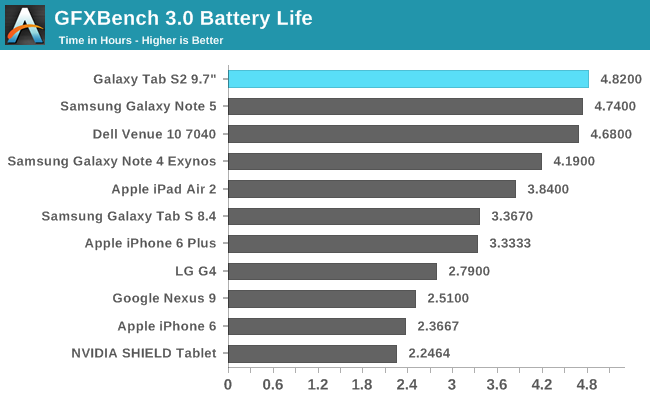
In GFXBench's battery benchmark test the Galaxy Tab S2 lasts for a very long period of time. However, this test really has two sides to it. While a device can last a long time, if it maintains a completely unplayable frame rate for the duration of the test then it's not really providing a better experience than a device that lasts half as long but runs at a very high frame rate which would actually be playable if the user was experiencing this type of workload while playing a game.
In this case, the Tab S2 is never even able to reach a frame rate of 30fps, and after around 25 minutes performance has dropped to 17fps. In contrast, the iPad Air 2 dies an hour before the Tab S2 does, but achieves a frame rate of around 50fps and maintains it for the entire time period. The Nexus 9 only lasts two and a half hours, but also achieves a very high frame rate during the benchmark. These results are a good example of how the gap between the GPU performance of the Tab S2 and the iPad Air 2 and Nexus 9 is actually much larger in the real world than single run GPU benchmarks show.
I think the Galaxy Tab S2 is definitely a case where a thin chassis was prioritized to the point where battery life suffered, and I don't believe that it was the right call. While the Tab S2 handily beats every other full sized tablet on thickness and mass, the battery life falls short in several situations. Web browsing battery life is not even close to where it should be, and BaseMark OS II shows that in a sustained CPU heavy workload the Tab S2 has to maintain a very low level of CPU performance to achieve the run time that it does. PCMark shows than in a heavily mixed workload there is the possibility of good battery life, but in my own experience which tends more toward web browsing, news reading, and working in Microsoft Office I've experienced battery life much closer to the results of BaseMark OS II and our web browsing test than PCMark's battery test.
Charge Time
Since tablets have significantly larger batteries than most smartphones they have been shipping with high wattage chargers since before fast charging came to smartphones. Unfortunately, the Tab S2 is an exception to this trend, and doesn't have any support for fast charging. I actually wasn't even sent the standard Samsung charging block along with the tablet, and since there's no fast charging support I just charged it with my 18W QC2.0 charger to ensure the block was more than capable of supplying 5W to the tablet.
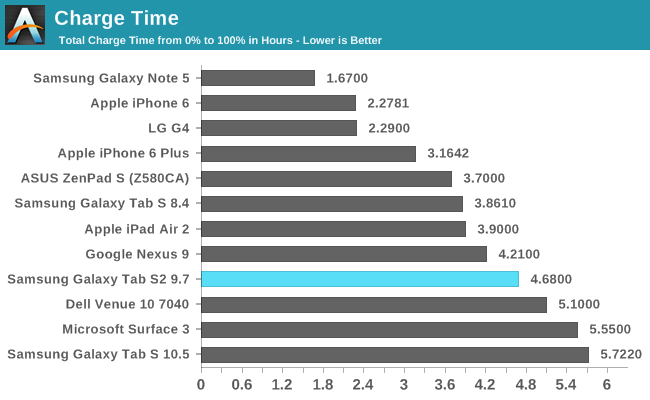
The Tab S2 takes 4.68 hours to charge, and considering its small battery capacity and the battery life sacrifices made because of it I think this was a big mistake on Samsung's part. If you're doing any CPU intensive tasks or doing a lot of web browsing it's very possible that it could take as long to recharge the Tab S2 as it lasted on battery. Suffice to say, both the battery life and the charging time on the Tab S2 are less than stellar.











162 Comments
View All Comments
WorldWithoutMadness - Thursday, October 15, 2015 - link
Pardon, is it typo on intro and design table, 'Samsung Galaxy Tab S2 8.4" ', is it really S2 or Samsung went wonky with this tablet line?Ryan Smith - Thursday, October 15, 2015 - link
That was indeed a typo. Thanks!donnieevans - Saturday, November 14, 2015 - link
I have a Samsung Galaxy Note Pro and this is the best table I've ever had! It's 32GB, can open multiple apps at the same time. The display is also amazing! Found at: http://www.consumerrunner.com/top-10-best-tablets/GodHatesFAQs - Thursday, October 15, 2015 - link
I bought a Tab S 8.0 earlier in the month, but had to return it over PenTile pixel arrangement which caused everything to look fuzzy and was not sharp at all. Display just didn't have the wow factor of last year's model. I think around 400ppi on RGB or 600ppi on RGBG PenTile is the real limit (at least for my eyes) for a display to be really sharp.I really hope Apple moves to 3072x2034 (3x rather than 2x) with iPad Air 3 with locally dimmed backlight like the iPhone 6s/Plus. It won't be as deep black as AMOLED displays, but I'm not willing to sacrifice sharpness for deep blacks.
Solandri - Thursday, October 15, 2015 - link
The whole point of pentile RGBG is that you don't need 600 ppi RGBG to equal 400 ppi RGB. The green resolution for that pentile display would be 600 ppi, while the red and blue would be 300 ppi.Your eyes are sharpest in green, with blue being really bad, and red only slightly better. Pentile attempts to match that (or put another way, RGB has way more R and B subpixels than it needs. Just look at the images on this site where the R, G, and B channels have been reduced to 1/3 and 1/4 their original resolution. The image with the reduced blue channel is nearly indistinguishable from the original. The one with the reduced red channel is barely distinguishable. While the one with the reduced green channel is absolutely terrible.
http://nfggames.com/games/ntsc/visual.shtm
In other words, if the individual pixels are smaller than the resolving limit of your eye (about 0.5 arc-minutes), then 400 ppi RGB can be replicated with 400 ppi RGBG pentile. If you don't believe me, consider that every color video format uses this trick to reduce bandwidth by reducing blue and usually red resolution. You've already been looking at the equivalent of pentile images on TV your entire life.
krumme - Thursday, October 15, 2015 - link
Thanx.Look at samsung galaxy s2 rgb next to a s3 pentile and its pretty obvious the s3 is far far sharper subjectively.
As for the tab s2 beeing unsharp its damn nonsense to me and i regard myself as very sensitive and prefer higher than 1080p on a 5 display. I dont know how close the person above uses the tab s2 but for my part its very much like my note 3 and it means the tab s2 looks sharper to me.
Now the s2 is damn light. Only a bit more than a s6plus lol so you use it more like a smartphone but never is it closer than 40cm for my usage. Its a 8 inch.
Wwhat - Tuesday, October 20, 2015 - link
NTSC was a very bad example of a color format, and you switched cause and consequence around, they had too little bandwidth, so they used desperate tricks to cram color into it, that's not an ideal situation.The same thing is still done but now to save cost and chip/PCB bandwidth, but that doesn't mean it's equal to the real thing.
Plus they go for the average person, which means that there can be a large number of people for whom it DOES make a difference.
Hell, when they introduced MP3 they also said that 128Kbit (and joint stereo) was the same as CD quality 'basically' (sometimes they even claimed the same for half that bitrate). But such things are based on theoretical papers and on the average person and on 'good enough for now' thinking, and don't represent a perfect world.
The difference between a person with very sharp eyesight and the average person can be astounding, some people have twice or even four times better eyesight than average. There are notable incidents in that with famous astronomers and jet fighter pilots demonstrating the difference in a pronounced manner. And it's a pure coincidence if you are such a person, but they do exist. But at the same time there are many people who truly could not tell the difference of course, but there is no reason to start denying each other's existence. Nor is there a reason to feel superior/inferior since we all have strengths and weaknesses in various areas.
thedons1983 - Saturday, October 17, 2015 - link
I'm sorry, but there is something wrong with your eyes... The one thing that these tablets have going for them, is the incredible screen. If you can't appreciate the quality of it, then there is something wrong with your sight.theduckofdeath - Sunday, October 18, 2015 - link
Full time Apple trolls on the internet?! What a shocker!lurker22 - Thursday, October 15, 2015 - link
Issue with android tablets, will they get software updates in a year or two